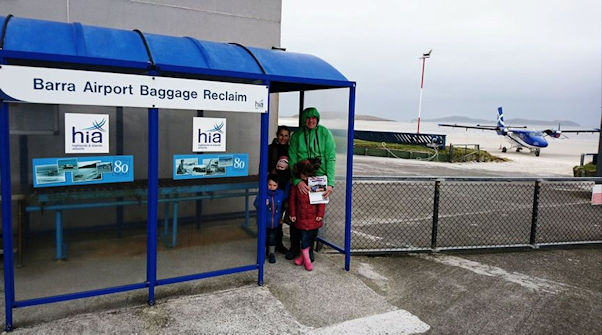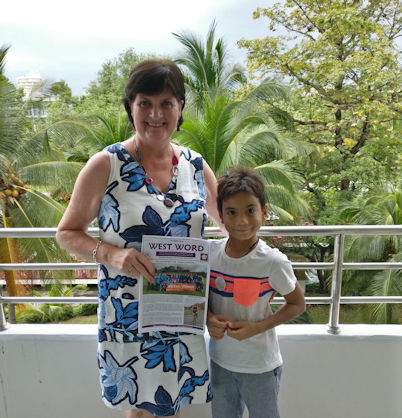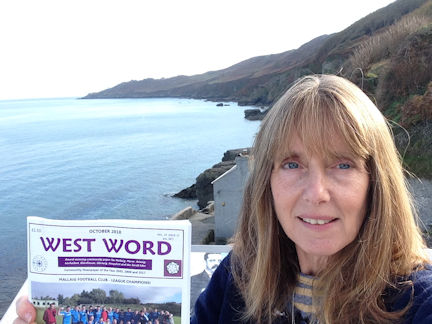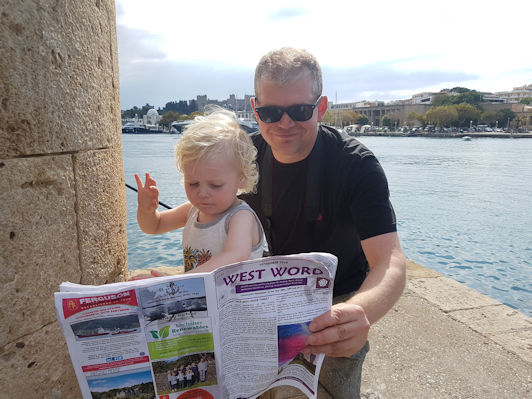SIR DAVID ATTENBOROUGH DEMANDS MSPs PROTECT 'GLOBALLY IMPORTANT' KELP BEDS
Renowned naturalist Sir David Attenborough has insisted it is "absolutely imperative" that action is taken to protect kelp in Scotland's waters. The Blue Planet broadcaster made what is thought to be his first intervention into politics north of the border to call on MSPs to "take the necessary action" to preserve the marine habitats.
He made the plea as Holyrood prepares to vote on new legislation, which if passed, would ban dredging for kelp in Scottish waters.
Sir David Attenborough said: "Charles Darwin was one of the first people to recognise just how important kelp forests are for our oceans, comparing them in diversity to rainforests. These kelp forests not only form an important part of the food chain, but also act as a vital habitat for a wide array of species. Their thick foliage offers food and safety from predators, and provides a nursery ground where juvenile fish can mature in safety. Look closely among the intricate stems and fronds of kelp, and you will find a range of fascinating sea life, from invertebrates such as sea stars, anemones and limpets, to mammals such as sea otters. Many of the fish species, such as cod, that are so important to us economically and culturally are also found here.
"For these reasons and many more (carbon storage being just one), it is absolutely imperative that we protect our kelp forests. It is perfectly possible to harvest them sustainably by removing their fronds while leaving the rest of the plant intact. But dredging - or indeed any kind of harvesting that removes the whole plant - is a wholly short-sighted measure that risks the wholesale devastation of our kelp beds.
"I urge decision makers to take the necessary action to protect these vital, and globally important, habitats."
Since last writing in West Word, a lot of campaigning has taken place and MPs and MSPs are having to sit up and take notice.
- Over 200 businesses have signed a letter against kelp dredging including the Fishermen's Associations with over 500 members, major seafood exporters and the Association of Scottish Shellfish Growers.
- Over 18,000 people have signed an online petition to completely ban kelp dredging.
The body of evidence from marine scientists and ecologists continues to grow as does the support for this campaign. The next key date for consultation on the application is on the 19th November, so more will be known soon about how this application is going to progress. Keep informed, get involved!
If you are a business get in touch on Facebook @nokelpdredging to add your name to the letter.
If you are an individual - support the campaign by liking and sharing messages from @nokelpdreding on Facebook and keep informed of what is happening. Write to MPs and MSPs.
Anne Widdop
LETTER FROM THE EDITOR
There's been a lot of work going on unseen in the world of West Word this month! We now have charitable status and a new bank account (see Ann's article opposite for details) and I'm very happy to say that we also have a new website, and it's once again possible to read all the news from the West online. Apologies (again) for the lengthy hiatus. The full archive is available (and searchable) again, and a selection of articles from the paper including colour photographs will be published every month, just as they used to be. The site can be found at www.westword.org.uk
No 'On and Off the Rails' this month as our railway correspondent, Sonia, has had a hectic month. She'll be back with us next month.
Once again my thanks go to helpers Anne and Miya for sticking address and postage labels on to the subscription envelopes and to Morag and Ewen for assisting with the printing this month.
Kirsty Bloom
CHARITABLE STATUS FOR WEST WORD
As of 24th October 2018, West Word has been awarded charitable status and is now Mallaig & District Newspaper SCIO no. SC048780.
This means we have met the Charity Test and are now a Scottish Charitable Incorporated Organisation, and we have been entered into the Scottish Charity Register. We have some work to do to transfer everything from the Company Ltd to the SCIO but once we and OSCR are satisfied it is done, we will close the Limited Company.
So why have we taken this step? When West Word was being set up, back in 1994, a firm of solicitors was instructed to compile the Memorandum and Articles which a Limited Company needs - similar to a constitution but much lengthier. As is the way of many solicitors, they 'took one off the shelf' and used it without reference to what West Word was or how it aspired to conduct its business. I must confess we didn't look at it for years, but when we had cause to do so last year we realised it was completely not fit for purpose and bore no relevance to what we required.
A number of years ago, it would have been impossible for a business like West Word to get charitable status. However, the new SCIO format is flexible and is for businesses who want the same protection that a Company Limited gives. If anyone would like to see the charitable objects we meet in our constitution, you can look online at www.oscr.org.uk or ask the Editor to email you the list. It's worth mentioning here that some people are confused about a charity making a profit. You're a non-profit making charity, they say, how can you make money? The answer is that any and all of the profit goes back into the business; none of the Trustees benefit in any way. Most charities employ paid staff, to carry out services essential to the charity - like our Editor!
We have a new bank account so if you are sending us money, please use the details below! The old bank account will stay open until it is clearly no longer being used.
Bank of Scotland, sort code 80-08-94, account no. 10076567, account name Mallaig & District Newspaper SCIO.
Ann Martin
West Word Chair
KNOYDART
It's been a very wet month here, with what felt like days on end of nothing but rain (actually, who am I kidding? It WAS days on end of nothing but rain!). The rivers were good proof of that, near bursting their banks with an impressive amount of water. And now, as we near the end of October, there was a very fine dusting of snow on the tops this morning. Winter is not coming. Winter is here.
Anyway, moving on … we are delighted that Knoydart Community Hall has been selected by the Co-op as one of its "great causes to support" for the forthcoming 12 months, beginning on Sun 28th October 2018. When members of the Co-op buy Co-op branded products and services, the Co-op will give 1% to our cause. In order to do that, we need folk to support Knoydart by going online (to the Co-op website) and selecting us as your cause for the year. If you aren't a member of the Co-op already then maybe you could sign up for us. Please. (coop.co.uk/membership #coopway #loveknoydarthall). Also in Hall news, the line-up for New Year has been released, featuring Alexander MacKillop, Levack, Luc McNally, Craig Baxter and Hannah Macrae. Should be a good!
The new Operations Manager for the Foundation has almost been selected. There were 13 formal applications received although over 50 were requested. There will also be a new person moving to the village all the way from north Devon to work in the shop.
In Forestry news the proposed new woodland at MaryAnn's point has been approved by the Foundation following positive community feedback, and planting of more native woodland in Airor is set to commence soon now that the trees have started arriving. I believe there is something like 80,000 trees but don't quote me on that!
There was a fabulous Italian night in the hall (Cabaret Selvaggio), which indeed was so popular and fabulous I missed out because I never got my name down in time! But by all accounts it was an awesome night. I only wish I could have seen some of the tremendous acts in person. Who knew Drama Dave could have kept such talents hidden??
And, to end on a mysterious note….Inverie has been experiencing a curious case of missing fruit. Whole trees - private trees in people's gardens might I add - stripped bare of their fruit in the dead of night. No one knows who the culprit is, but we are all on the watch for a suspicious number of apple pies or pear puddings.
Heather Robb
ISLE OF MUCK
Returning to the island with my new knee after heavy delays due to Storm Callum and associated weather events. It was Saturday 13th afternoon Loch Nevis and soon after her arrival we were told that the run was cancelled. Consternation among the 50 or so passengers almost all of whom were travelling to Eigg. A tribute to Eigg's success as a visitor destination! As usual it was Arisaig Marine who sailed to the rescue. The Sheerwater set out in the gathering darkness under relief skipper Christopher Dyer and most of the stranded passengers were able to reach their destination with only a few hours delay. Jenny and I sought refuge in the Arisaig Hotel and were able to return next morning courtesy of Isle of Muck Shooting Estate on Briscoe.
Shooting has been the major event on Muck with parties coming and going and Sheerwater doing four charters each week, mainly with Ronnie or Charlie in command. Plenty of dressed birds available for those looking for a change of diet.
Down at the school we have bid farewell to headmaster Andy Murray who has left us for a new post in Forgandenny. No sign of a replacement yet with disappointment tempered by the prospect of seeing a lot more of the popular Mr Norman. Meanwhile a new fence has arrived for the Forest School. Whether this will be to keep the children in or the wildlife out is not clear.
In the bigger picture this month the subject is The Jacobite, a great West Highland success story. Last September, wishing to relive my youth when I often travelled by steam train, I joined a short queue at FW station to buy a ticket from a polite young man who found me a seat. It was expensive but it must be remembered that for every train West Coast Railways pay Network Rail a considerable sum. Not surprising - a Black 5 must do far more damage to the track than a sprinter. The train was full - of course. Half the patrons appeared to be from overseas. The train was clean and there were few smuts from the seven tunnels entering through the open windows.
There was a downside - there always is. Worst was the lack of announcements or commentary. Even at the Harry Potter Viaduct little was said. The recorded story of Concrete Bob and building the line would have been interesting, though possibly not in every carriage. The trees. The loco returning to FW tender first less than enhanced the experience. But all the same it was a very enjoyable afternoon. Well done West Coast Railways!
Next month in the bigger picture I return to the waters and another success story. Fish farming and Marine Harvest.
Bye for now
Lawrence MacEwen
ISLE OF CANNA
The Isle of Canna Community Development Trust are pleased and very proud to announce that Canna is now being powered by Renewable Energy. Our six turbines are up and running and the solar panels are working well even on dull days. CREEL, our power company, took over on the 25th October but we hope to have an official opening ceremony in spring 2019.
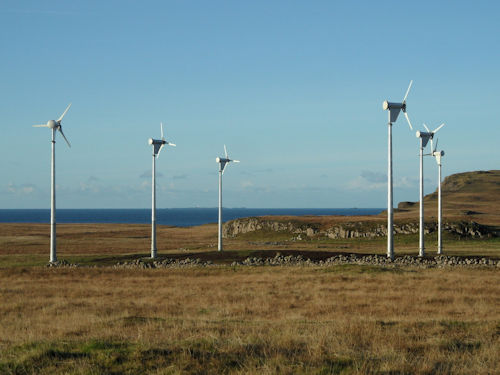
We would like to take this opportunity to thank everyone who has been involved with this project over the many years it has taken to get to finally being able to produce green energy.
For a small community this has been a massive project but we have had help and support from many agencies and individuals and if we can do it then anyone can.
Cattle sales in October were pretty dire but at least over the year sheep sales have been good. New Cheviot tups have been bought at Dingwall Mart and should be arriving on Canna next month.
Geraldine MacKinnon
Criomagan (Crumbs) from Canna House
October has been an exceptionally busy month in Canna House with the ongoing window replacement and drainage works. 13 windows have been replaced and contractors have been on site now for over a month. This is the first phase of a three phase programme of reparation works to work towards making the House wind and watertight, in preparation for opening to the Public in 2020.
The inaugural Tobermory Book Festival, "West over Sea", was the location of the launch of the first published collection of Margaret Fay Shaw's photography collection, Eilean (Island) edited by Archivist Fiona Mackenzie. Published by Birlinn Publishers, the book took Fiona over a year to compile and edit and it includes images from Margaret's travels through Skye, South Uist, Barra, Eriskay, Mingulay, the Aran Islands and of course, Canna. Fiona has matched the photos with excerpts from Margaret's writings, books, letters, diaries and broadcasts to help put the story all in context.
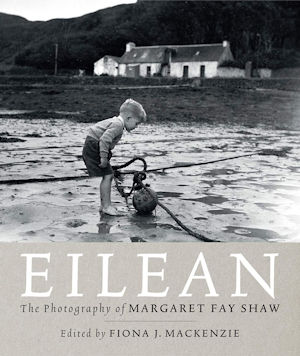
Fiona said "I wanted this book to be more than a collection of pictures with just a name and date. I wanted the words to match the images and to tell us about Margaret Fay Shaw as a person, not just a famous folklorist. Most of these images have not been seen before and include personal family snaps as well as some of the more iconic images of crofting life in the Inner and Outer Hebrides in the first half of the 20th century."
The launch on Mull took the form of a three way presentation by Fiona, biographer Ray Perman and Prof Hugh Cheape and was a sell out.
Fiona MacKenzie
ISLE OF RUM
It really feels like winter on the way now on Rum. The clocks have changed, the CalMac timetable has changed, it's the end of the stag season and the rut and we've had the first sprinkling of snow on the high peaks. The last Saturday evening CalMac of the season came in all lit up in the dark looking very festive.
Ranger Trudi has finished her Rangering duties for the season but is busy with her art and photography and hoping to be Rangering again next spring. Kim's Cafe is also finished for the year and has had a fantastic summer season with great reviews. Kim and Ashton had a well-deserved 'summer' holiday off island to recuperate.
We've had some hardy bushcraft survival folk over this week sleeping under the stars and foraging for their supper and we're still getting folk coming off the ferry with rucksacks and heading into the hills so Rum is not quite closed for the winter yet though.
We welcome back Abby and her son Leo - after a few years off Rum Abby has returned and it's lovely to have her back. Storm Callum made a brief appearance with a few trees down here and there but no major damage anywhere otherwise.
The hokey cokey of ferries with the tail end of the Nevis in annual dry dock followed by a few days of technical issues meant some people were stranded here, others were stranded off and the vet who visited to treat the SNH Highland cattle herd and Rum ponies with winter meds and check-ups ended up staying a night he hadn't been planning for.
Up on Croft 3 Nic has been making santa hats for crochet creatures and packing up orders to send off thanks to a flurry of online interest. Now the egg laying season is well and truly over the Croft 3 chickens are back free ranging around the croft once more and the sheep have already regrown all the fleece sheared off them a few months ago in preparation for the winter ahead.
Andrew Beaton celebrated his seventh birthday with a party in the village hall.
Nic Goddard
ISLE OF EIGG
Great end to September on Eigg with a party for the biggest number of significant birthdays this century! A whole bunch of folks have turned 40 this year: George, Tasha, Tamsin, Owen; Francis turned 30 and Marie and Colin 60! With a dress code of black tie and wellies, islanders and friends had a ball in a community hall also totally dressed for the occasion in yards of lights and organza! It was brilliant fun to get so glammed up and dance our wellies off! Thanks again to Eilidh, Tam and co for great tunes, and to the Lord of the Isles himself for his nifty turn on the decks. And many happy returns to you all!
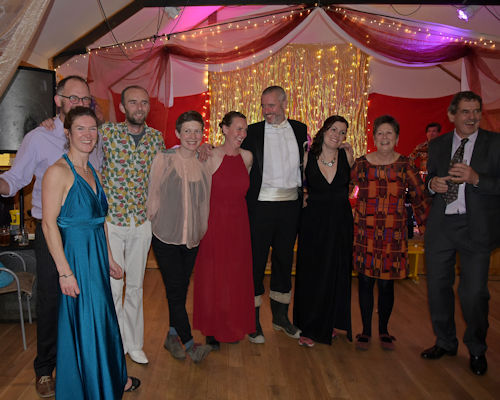
October was busy too with a few more birthdays: it was Peggy's turn to celebrate on the 10th as she turned 88. Our amazing local treasure, still knitting hats and socks as a stalwart member of the Isle of Eigg Craft Shop, had a great day seeing family and friends dropping in on her all day. We hope she is enjoying her trip to Yorkshire!
It was also time to say goodbye to Andrew Murray, our Muck and Eigg Head Teacher, returning to Brechin with his family. They will be much missed and have promised to come back for holiday visits. In the meantime, we hope that the £300 which was collected on the two islands as a thank you present will come in handy for them. Having successfully managed to foil plans to have future Heads based on the mainland, which would have been completely unworkable for our two schools, we now hope that a new appointment will be made soon. But is seems that rural teachers are as difficult to recruit as rural GPs.
The October break was busy on the island, with university groups from Dundee and Herriott-Watt back for their annual renewable energy study visits, but very sadly John Booth, who over the years had given these groups many detailed and memorable lectures on a system he was so instrumental in setting up, was no longer there. On 20th October John, who bravely and stoically endured his terminal illness for a number of months, passed away peacefully at his home, aged 74. John, who came to Eigg 17 years ago from Yorkshire to do up Galmisdale farm house with his wife Christine - the two of them were a fantastic team - made a huge contribution to life on Eigg, serving as Isle of Eigg Heritage Trust director, Eigg Residents' chair, Eigg Electrification project director and chair of Eigg Electric. His lively presence and caustic wit will be very much missed and our heartfelt condolences go to Christine, Victoria and Mathew and their families.
Camille Dressler
Canna Rangers - October update
We're now coming to the end of October and there has definitely been a change in the season with snow dusting the tops of the mainland mountains. This month we started a Wetland Bird Survey (WeBS) on Canna following the shoreline from the pier out to Tarbert. This survey aims to monitor non-breeding waterbirds throughout the UK and counts are coordinated nationally. On specific weekends each month you will find lots of birdwatchers and rangers out walking the shorelines! Our survey had the usual suspects of Curlew, Grey Heron, Mallard, Oystercatcher, Greylag Geese, Shag and Redshank but the stars of the survey were five Barnacle Geese and a White-tailed Eagle. For a couple of days near the start of the month we had approximately 11 Whooper Swans in the bay including adult and juveniles and there has also been a small group of Wigeon.
Gillian has been looking a bit more closely at the plants of Canna this month as she is taking part in a drawing "challenge" known as Inktober. The idea is to do a drawing a day throughout October and so she decided to draw plants that are found on Canna. She has picked a variety of plants from the common Dandelion, to the carnivorous Sundew to the rarer Adder's-tongue Fern. It is a great exercise to highlight how amazing plants are in their design and how fascinating they are once you take a closer look.
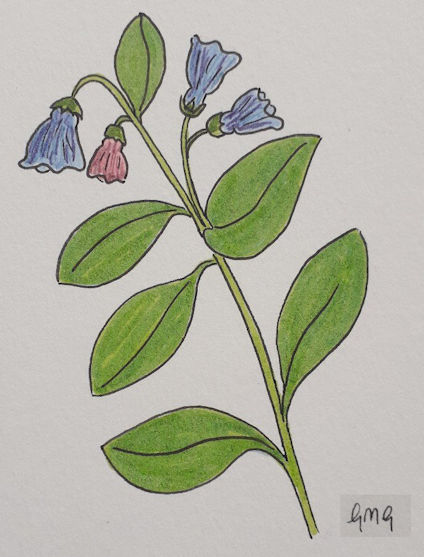
We also ventured onto the mainland this month, down to Ben Lomond for a NTS Natural Heritage Gathering where we got to meet other countryside staff working for the NTS. Although only a short time to explore the area we were treated to the sound of Nuthatch on the shores of Loch Lomond.
Keep up to date with our wildlife sightings on our twitter page @CannaRangersNTS
Gillian & Mike
Craig's Ancient Military find!
Craig Lovat of Eigg Explorers was busy shovelling topsoil from Bayview for his garden when he came across a thin metal oval shape about 6cm in length, 3cm in width, looking very much like bronze. Cleaning the plaque, he could read the inscription Fort William Volunteers on each side and could discern a fairly worn thistle and crown in the middle. Realising it could be a military insignia, a quick search on the internet confirmed his hunch: this was the breastplate of a local militia operating between 1794 and 1816.
Scotland has a long tradition of auxiliary forces - Militias, Fencibles and Volunteers - which were raised for internal defence. The Fort William Volunteers seemed to have been one of the many auxiliary forces raised for internal defence during the Revolutionary and Napoleonic Wars between Britain and France and their respective allies.
When Craig excitedly came to show me his discovery, I immediately thought of Neil MacQuarrie, as he was known to have been in the militia, although I had never heard the name of the volunteer corps that he was part of - like the Small Isles Rev. Donald MacLean. Now Bayview is smack bang in the middle of where Neil MacQuarrie used to live, on what was said to have been the largest croft in Cleadale, allegedly apportioned to him by his brother in law, Dr MacAskill, who was the island Baillie at the time. And then Duncan Ferguson reminded me that in the Eigg tradition, Neil was referred to as a' Chòirneal Ban, the fair-haired colonel!
So it very much looks like the topsoil dug by Charlie Mackinnon as part of his house renovation at Bayview has yielded an important clue about one of Eigg's better-known characters. For Neil was also known for the illicit whisky he made together with his friend the Gobha Mòr from Lageorna, in a little cave fed by a burn hidden in the cliffs on the Cleadale shore.
CD
Arisaig Community Trust
You may have noticed our new logo on our Facebook page or on the playing field/toilet signs in the village. It was adapted by Calum Kirk from the James Porteous Wood artwork on the side and front of the Land Sea and Islands Centre and we think it's a great modern upgrade to his work.
We are as busy as ever - the car park is now finished at the LSIC and after waiting all summer for the building warrant for the workshop, it has finally come through. Work is almost complete on the outside and we hope it will be fully functional before Winter sets in! The electric car charging point will be installed after completion, coordinated as part of the Eco Project.
Volunteers have been busy upgrading the playing field path and painting two compost bins for grass cuttings which we hope will make mulch for village gardens. The path is now much more sturdy, suitable for pushchair and wheelchair access. The gents' toilet in the village has been painted by Gill and Arthur Whittaker and Chris Smail volunteered to build a fence around the side of the building. This will need painting when we get some dry days! Let us know if you are free to help! Neil and Eileen Cameron have cleared a lot of overgrown trees and undergrowth at the side. Our Eco Project manager Alison is planning to improve this area with further planting as she has done in front of the toilets.
At the end of August the original World War 1 Arisaig and South Morar record book was installed in its custom built case, originally made by Frank Baillie and adapted by director Peter Fleming. It now sits permanently in the LSIC for public viewing. The WW1 centenary project has also funded the newly completed path up to the war memorial, opposite the Primary School.
Back in April when we did our community housing survey, a number of Arisaig residents said they were looking for adaptions to make their homes more accessible. If this was you, or you know someone who needs an adaptation, please get in touch with one of our directors or by email: info@arisaigcommunitytrust.org.uk
The Eco Project has another event scheduled for November 24th - Willow work and clothes swap at the Astley Hall from 2-5pm.
And we will be serving refreshments at the Christmas Fair on 29th November in the Astley Hall.
Behind the scenes, we are pursuing other projects: upgrading the buildings at Arisaig Railway Station, a community land buy-out and extending the Land, Sea and Islands Centre. All pretty big tasks that keep us busy busy!
Mallaig and Traigh public toilet and motor home facilities project,
Road to the Isles Facilities Group (SCIO)
It's been another roller coaster month, the high point being the award of £300k from the Rural Tourism Infrastructure Fund, although there are some conditions we have to meet. This is a very positive step and will hopefully influence the match funding which we should have confirmed in the next few weeks. Another high was the registration of the Road to the Isles Facilities Group with OSCR (Scottish Charities Register) - this was no easy task!
Planning for both the Traigh and Mallaig projects have been in for some time and there has been a number of positive responses from the statutory consultees, some with conditions. There has also been a number of objections from residents regarding the proposed site of the Mallaig toilets. There is a document on the Highland Council planning website which we hope will provide clarification on some of the issues raised. We have been looking at alternative sites however there isn't that much land available. One site was ruled out due to its proximity to a sewage pumping station; there is another near the industrial units but it is tight, and we are waiting on confirmation from the roads department. That said, the site at West Bay car park is still our preferred location.
We are open to any thoughts or issues people have so please don't hesitate to contact us or speak to us in the street.
Stuart Griffin
Road to the Isles Facilities Group (SCIO)
roadtotheislesfacilitiesgroup@googlemail.com
NEWS FROM MALLAIG HARBOUR NOVEMBER 2018
Mallaig Ice Factory
The dramatic downturn in fishing boats using Mallaig Harbour in recent years has already impacted on the availability of shoreside facilities.
The latest blow is the decision by Denholm Fishselling Ltd to close down the Mallaig Ice Co later this month. The Mallaig Ice Co was formed in 1948 - 70 years ago - and its closure is a sad reflection on the current state of the west coast fishing industry.
However the Mallaig Harbour Authority has sourced 50% EU funding for a new containerised ice plant which is due to arrive on site early January 2019 and allowing three - four weeks for erection and commissioning, becomes operational late January.
There will inevitably be a lack of ice during the change over period from one ice plant to the other and unfortunately this will impact on the fishing fleet using the port.
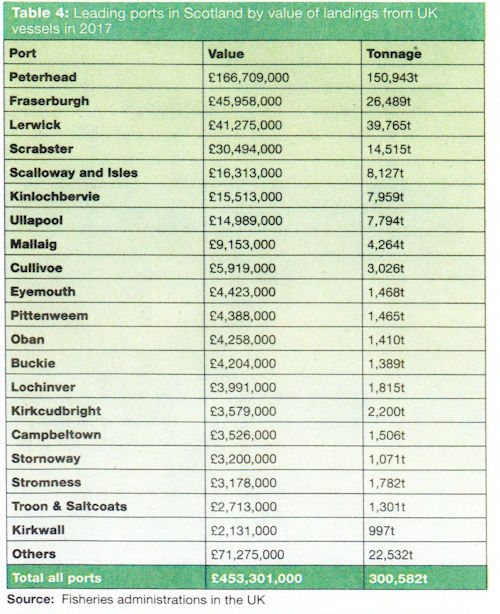
Landing Values
As can be seen from the attached chart the port of Mallaig is ranked No 8 in Scotland on the value of catch landed for the calendar year 2017:
Here is an interesting photo showing the original Lovat Pier (bottom right) and the wooden pier constructed by British Railways. Not sure of a date, 1920's?
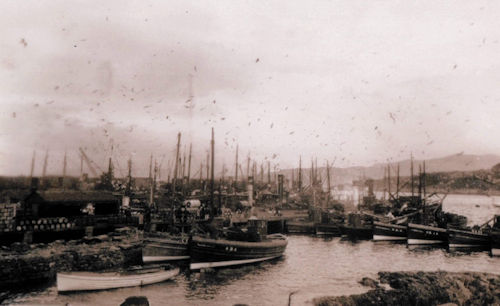
Robert MacMillan
CEO
01687 462154 info@mallaigharbourauthority.com
Mallaig Lifeboat Log
2nd October 2018 Assisting Stranded Ferry at Kylerhea
Launched by Stornoway coastguards to the assistance of a grounded ferry in the Kylerhea narrows at 16:25. Whilst approaching the landing the ferry was carried across the jetty, stranding on the falling tide. Two nearby workboats attempted to free the casualty without success. Arriving on scene at 16:55, the Lifeboat did not attempt any recovery as the ferry was completely stranded. The Lifeboat stood by until 21:30 when sufficient water was under the casualty. The tow rope was passed over and made fast to the starboard quarter of the casualty. Power was applied to maintain a strain on the tow rope and at 21:41 the casualty was successfully refloated. The Lifeboat illuminated the casualty's mooring and stood by until the casualty was moored. With all systems ok with the ferry the Lifeboat returned to Mallaig, ready for service at 22:30.
13th October 2018 Assisting Police in Recovery of Deceased
During a routine exercise the Lifeboat was requested to return to Mallaig to convey Police to the Isle of Eigg to investigate an unexplained death on the Island. As the Lifeboat was exercising in the locality of Arisaig harbour, the Police, who were travelling from Fort William, were asked to divert to Arisaig Marina for pick up. The Lifeboat departed Arisaig at 11:40 and berthed in Eigg at 12:10. After Police concluded their investigation the crew assisted in the recovery of the person's remains back to the Lifeboat for transportation back to Mallaig. Arriving at Mallaig at 15.10 the Lifeboat was fuelled and made ready for service before the Private Ambulance arrived to convey the person's remains to Fort William at 15:40.
14th October 2018 Medivac from Isle of Canna
Launched to convey Paramedics to the Isle of Canna by Stornoway Coastguard at 17:25. A resident of the Island was in need of medical attention. Arriving at Canna at 18:30, the medics were taken to the patient locality by local Coastguard. After assessing the patient it was decided to transfer to the mainland for further treatment. Once patient and medics had returned, the Lifeboat departed Canna at 19:20. Arriving back at Mallaig at 20:30 the patient was transferred to Fort William's Belford Hospital by Ambulance. Lifeboat ready for service at 20:45.
Return to Canna
My name is Tim Shea. I'm a 22-year-old recent college graduate from the United States. This fall, I spent nearly two months volunteering with the Isle of Eigg Heritage Trust, and I'm currently volunteering on the Isle of Canna. This visit has made me the first member of my family since my ancestor, Murdoch Kennedy, 227 years and seven generations later, to return to the Small Isles of the Hebrides.
From family oral histories and J.L. MacDougall's A History of Inverness County, I know that Murdoch left the Isle of Canna with his five brothers in 1791 and took a boat to Nova Scotia, Canada. He ultimately settled on a plot of land beside Loch Ainslie, in what would become the town of Kenloch, near Inverness, Cape Breton. Five generations after Murdoch arrived, my grandfather Hugh Kennedy, grew up on this same farm in Kenloch, where he and his siblings were raised speaking Gaelic as a first language. As was Cape Breton tradition, Hugh could recite his ancestry and family's history back to their arrival in Nova Scotia, as well as the many struggles that those before him overcame in this new harsh landscape.
I was raised in the United States, but my mother - who moved to Boston permanently from Cape Breton in 1980 - made it a tradition for my family to visit Nova Scotia every summer. In fact, the greatest memories of my childhood come from these yearly visits to Inverness, Cape Breton. These trips were characterized by ceilidhs in Mabou, step dancing and bagpipes at the Broad Cove Concert, my grandmother's occasional Gaelic ballad around the campfire, and my sister's time at a fiddle school where musicians like Brenda Stubbert and Buddy MacMaster taught. The result of this experience was that, despite being a seventh generation North American, by the time I was primary school aged, I was well aware of the importance of my Scottish Gaelic identity to my family and their community.
While I grew up proudly Scottish (*-Canadian-American), it was only over the last few years that I've learned of the Isle of Canna as the specific geographic origin of this identity, as well as the historical context of the Kennedy's migration from the Hebrides. I had always understood from my mother that they left Scotland during something called "the Clearances" and that it was not exactly a migration of choice. Through various readings leading up to and during my time on Eigg, I've learned of the Jacobite "45's" and the resulting brutal British military crackdown on places of support for the Catholic Stuarts, like Canna and Eigg. I've also read about the detrimental impact of landowners restructuring Hebridean island economies to respond to the Southern British demand for sheep wool and kelp farming. I now have a better sense of the ultimate degradation of kinship ties between clan chiefs and their members and the emergence of the feudalistic laird-tenant system, which set the stage for the period of mass migration and eviction that we now know of as the Highland Clearances.
In his novel and short stories, Alistair MacLeod, the award-winning Cape Breton author, who was a member of the same Broad Cove Church parish as my family, paints a picture of the intergenerational trauma that the Clearances had on his characters. In his final short story, "Clearances," published in 1999, a flashback follows a Canadian man who is on a week's furlough in Britain during his service in the Second World War. While on a train to the Highlands in his Canadian Military uniform with several Gaelic place names written on scraps of paper in his hand (which one assumes have been passed down orally through generations), he comes across a shepherd addressing his dog in his familiar Gaelic language:
"Haltingly he said to the shepherd 'Ciamar a tha sibh? (How are you?) Nach eil e latha breagha a th'ann? (Isn't it a nice day?)'
Instantly the train coach fell silent and all eyes turned towards him. 'Gle mhath. S'e gu dearbh. Tha e blath agus grianach. (Very well. Yes, it's sunny and warm.),' said the shepherd, and then eyeing his epaulette said in a measured English, 'You are from Canada? You are from the Clearances?' He uttered both statements in the form of questions and pronounced the word 'Clearances' as if it were a place instead of a matter of historical eviction."
To me, this and other depictions by MacLeod speak to the commitment of the Scottish Gaelic diaspora to its cultural identity. However, it is a commitment that falls under a cloud of lingering trauma and unanswered questions, which continue through generations and are rooted in a lack of contact with the romanticized, and perhaps no longer existant, origin of their identity.
When it comes to my ancestors, I now know that their departure at the very start of the Clearances likely had a significant deal to do with their Catholic religion, which was no longer as protected on Clanranald lands by the 1790s. One source that I came across in the Eigg archive actually highlighted the migration of my ancestor and his brothers, as well as their intimate ties to fellow Roman Catholic Eigg members of Clanranald. In Chapter four of Lucille Campey's, After the Hector: The Scottish Pioneers of Nova Scotia and Cape Breton 1773-1852, she cites the "some Eigg families and six Kennedy brothers from Canna" who upon arrival in Nova Scotia in 1791 chose to settle together in the western Cumberland County. However, after a decade, many from this party moved back east to be near other members of their Clanranald group and the churches of Antigonish "where they could practice their Catholic religion."
I still have many unanswered questions about my Kennedy ancestors and their migration from Canna. For how many generations did they live on Canna? What was their role in the 45's? Was their desire to openly practice their Catholic faith the primary reason that they decided to migrate to Canada, or were they also facing potential eviction? Did they ever think they might journey back to see their parents and family members in Scotland? And of course, what would they think of me and my trip back to their homeland, 227 years after their departure? I would like to think that the six Kennedy brothers would be happy that, although I grew up unable to speak their Gaelic language in a very different world from the Small Isles, I was still raised with a strong awareness and celebration of my Scottish Gaelic identity, as well as a desire to learn more about them and the island home that they left behind.
Tim Shea
An Update to Knitting for Charity, Food Bank and Projects in Sierra Leone
We have had another good year supporting refugee camps via Edinburgh Direct Aid. Three full car loads have been delivered from North West Lochaber to the depot in Edinburgh. The organisers at Edinburgh Direct Aid are delighted to accept our knitted donations knowing they are always of a very high standard. Not all our knitters are local but they are West Word readers. Thus, our local thanks extends to Maggie in Duror, Carole and Sandy in Essex, Pat in Glasgow, Pat in Suffolk, May in Glasgow, Sheila in Inverurie and Karen in Durham. You have crafted the cosiest of baby bags, soft toys, slippers, bed socks, socks, a huge variety of baby items, sweaters for teenage boys and girls, gloves, hats, scarves, squares for blankets, baby blankets…. the list goes on and is much appreciated. Details of the work done by Edinburgh Direct Aid can be seen on their website.
https://www.edinburghdirectaid.org/
There has been a considerable drop in donations to Food Bank in Fort William. This is not just a local issue but much wider spread and referred to as Food Bank Fatigue. As the colder weather comes and folks are struggling with the increase in fuel bills a helping hand from the Food Bank is essential and often requested by families on low incomes. Any donations (please check date on product) can be left in the Church of Scotland porches Arisaig and Mallaig. If anyone wants to organise a collection between now and Christmas it would be appreciated. The opening times of the Food Bank are not always convenient for leaving donations but there is a very large trolley in Tesco, Fort William. They have no objection to bags of items being left.
Finally, local shops (Togs in Caol and Mallaig Toys and Gifts) and many generous individuals have very kindly supported small projects to make education more accessible to impoverished communities in Sierra Leone, West Africa. Thank you. To begin with we shipped out educational items but once the country started getting back on its feet after the ebola crisis the local markets started to become busy, bustling places. I think the number of pencils, rulers, erasers, sharpeners, maths sets art and craft items we have sent could easily have stocked a market stall. To assist the local economy we are now sending donations to our trusted colleagues who will buy and supply the education groups. I can assure everyone who has given a donation that 100% of the money buys essentials and receipts are kept for evidence. The participants in the learning are also given a meal. It is difficult to learn with an empty, growling belly. I recently visited Freetown and more rural parts to see how the projects were developing. Astonishing is the only way I can describe it. I wish I could make £1 go as far as they can. Communities have taken ownership of the projects, people are volunteering their skills and time, women are being empowered and young folk are daring to dream. Every development is discussed at community level and endorsed by the elders and chief. Any whiff of corruption or bribery is simply not tolerated by anyone in the community.
They have designed and developed these projects to suit their needs and not the needs perceived by the West. They all send their many blessings to all the people here in Scotland who have given items, donations or their time. Their stories range from being sad to inspiring and I could fill West Word with them.
For anyone who is interested all the projects are described in detail at www.aret.scot
Morag Keenan
Testing the BMW i3 Electric Car
Firstly my thanks go to Alison O'Rourke and the Arisaig Eco Project for giving me the opportunity to test drive the latest BMW electric car. I contacted Alison after reading an advert she had placed in West Word inviting members of the public to take part in road testing of the car.
During our conversation I happened to mention that in the early 1970s I was involved as part of a team that developed and manufactured Electric Traction Motors for a company called Enfield Automotive. At the time I was working for a company called Maudsley's - then a subsidiary of Lister Diesel Generators. Listers were well known for a wide range of 'diesel power packs' and these were produced in large quantities on a massive production line. Maudsley's, on the other hand, specialised in "one-off" made to order AC/DC rotating machines, and their electronic speed control systems. The only motor that they produced in large quantities was for the fork lift truck industry, mainly Lansing Bagnall in Basingstoke, Hampshire. Although produced in large quantities the motors were all handbuilt either in batches of 10 or 20. Every motor was rigorously tested to a very high standard, each with its own test certificate. During my spell at Maudsley's I witnessed thousands of these motors leaving the factory, and it was a very rare sight to see one returned as failed. If one did it was more often than not caused by misuse by the customer.
It was in the early part of 1973 that Maudsley's were approached as a possible supplier for Enfield Automotive's first electric car. A test rig was manufactured and soon the first traction motor was being built ready for evaluation. It was my job to work alongside the design engineers and put the motors through a rigorous series of tests. The motor was subjected to overloads and conditions that hopefully it was not going to face, but the design proved to be so good that it was adopted by Enfield within a very short time, and soon found its way into the "Enfield Electric Car".
It was interesting to learn that the car itself used parts from the Hillman Imp suspension and the final drive was from the 'Bond Bug'.
The car proved to be a great success and far exceeded expectations. It wasn't long before a larger motor was developed and ordered. This improved the car's power and acceleration-increasing its mileage between charges. Unfortunately the car was not looked upon as a valuable replacement for petrol or diesel cars. Pressure by the big oil companies ensured that the necessary finance required was not forthcoming. Various attempts to move the company to the Isle of Wight - and eventually Greece - did not prove to be successful and sadly the company folded soon afterwards. It is, in my opinion, such a pity as believe it or not the final specification was not too dissimilar from today's electric cars. A top speed of 90 mph was achievable - but sadly only a 55 mile range attained.
Now to the test drive
The BMW i3 Electric car is a delight to drive. The controls are positive and all in the right place. The car responds very quickly to any command given. The first thing you experiences the quietness which is slightly unnerving, but you soon get used to only hearing road noise.
I was given a brief tour of the car's controls by Rosemary Farrell of Auto Global Solutions - my instructor for the test drive - and it was time to hit the road. I was not expecting such a quick take off in the car accelerated to 60 mph very quickly, and you felt that there was plenty left. As soon as you took your foot off the accelerator the car immediately started to slow down very quickly, this being a feature as whilst deceleration takes place the traction motor acts as a generator putting power back into the battery. I found this to be a good feature as during the whole of the test drive I only used the brakes twice, each time to bring the car to a complete stop.
On arrival at Mallaig from Arisaig, Rosemary requested me to pull up at the charging point in the West Bay car park and she explained how to hook up the car using the three systems available. The BMW i3 is a hybrid, meaning that it has a reserve petrol engine fitted, just in case you run out of charge, or are unable to get to a charging point. After a 10 minute charge we took to the road again. Once again my driving was monitored by Rosemary to see if I could improve my driving efficiency. On arrival back in Arisaig, albeit too soon, I was pleased to be told that my driving efficiency was excellent and, based on this, I would probably achieve a full 183 miles on one charge!
As far as I can say the electric car is definitely a must. The only drawback is the price - a staggering £48,000. There are some pre-owned BMW i3's on eBay for around £12,000-£20,000 depending on age and condition. The only thing to take into consideration is that the battery life is eight years maximum and is expensive to replace. So if purchasing a preowned model this factor is probably the most important point to take into consideration.
Steve Roberts
Old Roads
Many moons ago Ann Martin asked me to write something about the old bridge which was rediscovered by contractors working on the new Criche Bridge near Arieniskill. Guilt has finally spurred me to action.
There has been a rolling program to improve bridges on the A830 between Fort William and Mallaig. When building the new structure at what is called Criche Bridge (presumably from Allt na Criche - the Boundary Burn - which runs beneath it) an older bridge was revealed. Vegetation had shielded this from view for many years. I became aware of it as the roadworks progressed and was delighted to see something from the early nineteenth century still intact. I stopped one day to take photos.
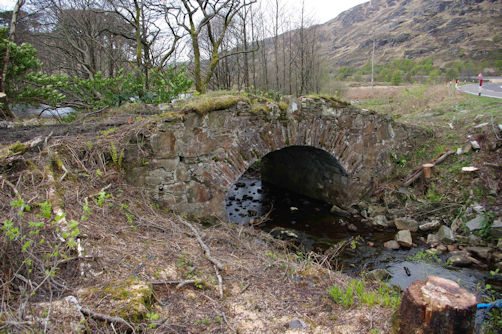
Some days later I was puzzled to see what looked like a sort of orange polystyrene foam filling up the gaps between the masonry. Next time I passed the bridge had gone and it was only in the following weeks that I learned the full story from the media.
It appears that the old bridge was too close to the new one to be kept. However it contained a colony of bats. A temporary bat shelter was provided and the entry holes in the bridge filled up. This prevented them returning to their old residence - which was then removed. However in order to provide a long-term home for the bats - which are protected by law - a new bat-house was built just a few yards away on the bank by the road. Stones from the old bridge were re-used in building this and special cavities were left to allow the bats to enter and exit.
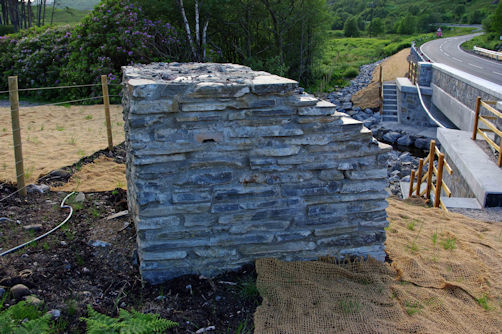
In the circumstances this is a good news story where all parties have tried to ensure that road improvements go hand-in-hand with protection of endangered wildlife. For myself I still have a sense of loss that another bit of Highland heritage has gone. It is perhaps not such a big deal as the removal of the Bronze Age cairn in Arisaig but in an ideal world they would both be preserved for future generations. If we had looked for them earlier - and planned a little more imaginatively - perhaps they could have been.
This allows us to reflect on the first roads in the area. We all learn at school that General Wade's military roads opened up the Highlands in the early eighteenth century. So they did - but they weren't built in our area. We know General Roy's surveyors came through Morar about 1750 because of his surviving maps of Scotland. However, as a military man he was primarily concerned with strategic issues - where the settlements were, what were the natural obstacles for soldiers to deal with. It was undoubtedly because of its logistical importance that the Morar Estuary was mapped in such detail.
The area probably had numerous rough paths worn by thousands of years of people and animals crossing the hills along the simplest and most convenient routes. They would have beaten their tracks across the landscape - just as sheep still do. Probably some such track had been worn between the ferry at Mallaig and the settlements of Morar using the natural pass by the Lily Pond. This and the surrounding lazybeds (still visible on the ground east of Lochan Doilead), are all marked by Roy's surveyors. But they obviously did not visit Loch an Nostarie or its neighbouring lochs since these are missing from Roy's maps.
At the beginning of the nineteenth century there was a conscious, government-backed attempt to open up the Highlands. If you are interested, the process is documented by ARB Haldane in his book New Ways through the Glens. Road-building was generally preceded by surveying and map-making and we have two maps for this area which survive in the National Records of Scotland. They are RHP 11606 by George Brown in 1796 and RHP 11625 by William Cuming in 1803. Both concern the projected road between Arisaig and Fort William. If you go to the National Records (Princes St, Edinburgh) you can see a digital version of each of these maps on what are known as the 'Virtual Volumes'. They are invaluable for showing us the settlements of two centuries ago.
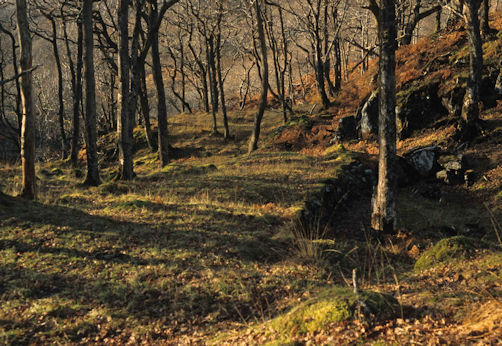
This road was eventually completed in 1812. Over the next 200 years the road has been extended, upgraded and built over to such a degree that it is difficult to tell the older sections from the new. However its course was occasionally changed and we can still see stretches of the older road east of Beasdale (above) and on the north side of the present road as you ascend the Muidhe (below). (Both of which I first spotted from the train - which often gives you a better perspective). You can also see bits of the old bridge and road at Morar (just west of the viaduct) - where they are being steadily eroded by the river. In time the New Road always becomes the Old Road but I would argue to retain these old structures wherever possible. The past enriches us - and the old stone bridges were aesthetically very pleasing.
Denis Rixson
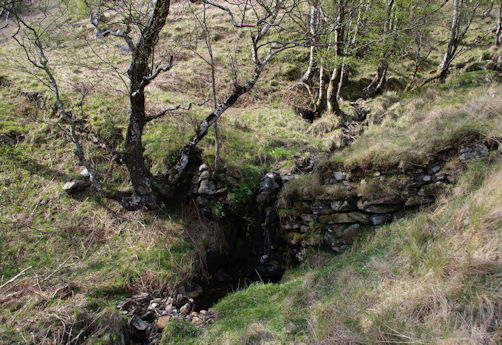
BIRDWATCH September 2018 by Stephen MacDonald
A fairly unsettled month of weather, with frequent wet days and strong winds.
With the winds predominantly from a south-west or west direction, the number of juvenile Manx Shearwater grounded was much higher than last year. The majority of the recoveries were from Mallaig, especially the harbour area. A few birds were also found in Morar and Arisaig. By the month end 420 individuals had been ringed then released back to sea.
Small numbers of waders still trickling through, with ones and twos of Whimbrel and Bar Tailed Godwit seen by Traigh golf course during the first half of the month. Two Bar Tailed Godwit were also seen on the Morar estuary on the 24th. At least two Greenshank seemed to be present on the Morar estuary throughout the month. Small groups of Dunlin and Turnstone were also seen at Traigh and Camusdarroch. On the 20th a Grey Phalarope was seen and photographed between Arisaig and Eigg from the MV Sheerwater.
The first migrant geese were reported on the 20th when a flock of 57 Pink Footed Geese were seen flying south over Morar. Subsequent reports came from Arisaig and Loch Ailort.
During the last week of the month small groups of Whooper Swans were seen heading south over Loch Nan Ceall and the Rhu peninsula.
Numbers of Red Breasted Mergansers built up on the Morar estuary and Loch Nan Ceall as the month progressed. On the 23rd of there were seven
Goosanders feeding at the mouth of the River Ailort. Four were seen on the river at Invercaimbe on several occasions during the month. Again numerous reports of Sparrowhawks hunting in gardens that have bird feeders. Most of these Sparrowhawks appear to be juveniles.
Sea Eagles reported from Arisaig and Morar. A Barn Owl was seen perched on the roof of the Prawn market, Mallaig on the night of the 9th, before it took flight over the CalMac office and fish feed store.











